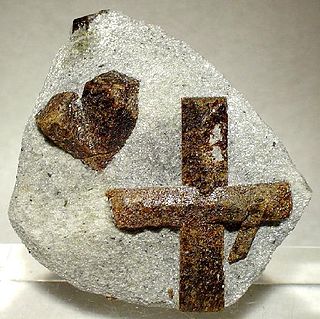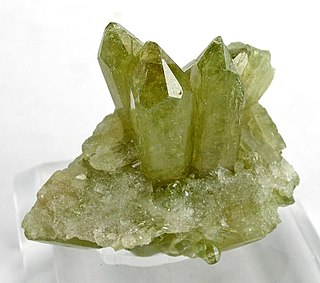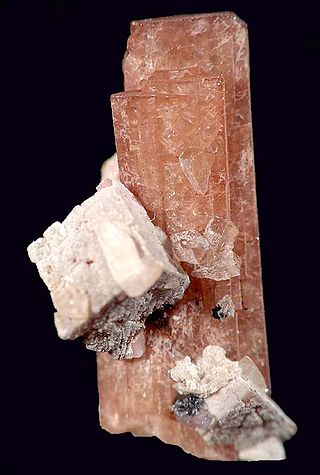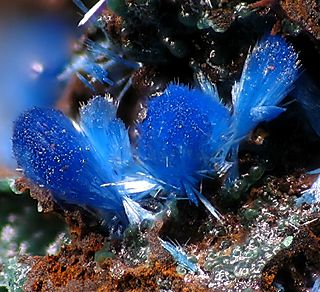
Cinnabar, or cinnabarite, is the bright scarlet to brick-red form of mercury(II) sulfide (HgS). It is the most common source ore for refining elemental mercury and is the historic source for the brilliant red or scarlet pigment termed vermilion and associated red mercury pigments.

Gadolinite, sometimes known as ytterbite, is a silicate mineral consisting principally of the silicates of cerium, lanthanum, neodymium, yttrium, beryllium, and iron with the formula (Ce,La,Nd,Y)2FeBe2Si2O10. It is called gadolinite-(Ce) or gadolinite-(Y), depending on the prominent composing element. It may contain 35.5% yttria sub-group rare earths, 2.2% ceria earths, as much as to 11.6% BeO, and traces of thorium. It is found in Sweden, Norway, and the US.

Petalite, also known as castorite, is a lithium aluminum phyllosilicate mineral LiAlSi4O10, crystallizing in the monoclinic system. Petalite occurs as colorless, pink, grey, yellow, yellow grey, to white tabular crystals and columnar masses. It occurs in lithium-bearing pegmatites with spodumene, lepidolite, and tourmaline. Petalite is an important ore of lithium, and is converted to spodumene and quartz by heating to ~500 °C and under 3 kbar of pressure in the presence of a dense hydrous alkali borosilicate fluid with a minor carbonate component. Petalite (and secondary spodumene formed from it) is lower in iron than primary spodumene, making it a more useful source of lithium in, e.g., the production of glass. The colorless varieties are often used as gemstones.

Rhodochrosite is a manganese carbonate mineral with chemical composition MnCO3. In its pure form (rare), it is typically a rose-red colour, but it can also be shades of pink to pale brown. It streaks white, and its Mohs hardness varies between 3.5 and 4.5. Its specific gravity is between 3.45 and 3.6. The crystal system of rhodochrosite is trigonal, with a lattice structure and cleavage in the carbonate rhombohedral system. The carbonate ions (CO2−
3) are arranged in a triangular planar configuration, and the manganese ions (Mn2–) are surrounded by six oxygen ions in an octahedral arrangement. The MnO6 octahedra and CO3 triangles are linked together to form a three-dimensional structure. Crystal twinning is often present. It can be confused with the manganese silicate rhodonite, but is distinctly softer. Rhodochrosite is formed by the oxidation of manganese ore, and is found in South Africa, China, and the Americas. It is one of the national symbols of Argentina.

Staurolite is a reddish brown to black, mostly opaque, nesosilicate mineral with a white streak. It crystallizes in the monoclinic crystal system, has a Mohs hardness of 7 to 7.5 and the chemical formula: Fe2+2Al9O6(SiO4)4(O,OH)2. Magnesium, zinc and manganese substitute in the iron site and trivalent iron can substitute for aluminium.

Bournonite is a sulfosalt mineral species, trithioantimoniate of lead and copper with the formula PbCuSbS3.

Vesuvianite, also known as idocrase, is a green, brown, yellow, or blue silicate mineral. Vesuvianite occurs as tetragonal crystals in skarn deposits and limestones that have been subjected to contact metamorphism. It was first discovered within included blocks or adjacent to lavas on Mount Vesuvius, hence its name. Attractive-looking crystals are sometimes cut as gemstones. Localities which have yielded fine crystallized specimens include Mount Vesuvius and the Ala Valley near Turin, Piedmont.

Warwickite is an iron magnesium titanium borate mineral with the chemical formula (MgFe)3Ti(O, BO3)2orMg(Ti,Fe3+, Al)(BO3)O. It occurs as brown to black prismatic orthorhombic crystals which are vitreous and transparent. It has a Mohs hardness of 3 to 4 and a specific gravity of 3.36.

Cerite is a complex silicate mineral group containing cerium, formula (Ce,La,Ca)
9(Mg,Fe3+
)(SiO
4)
6(SiO
3OH)(OH)
3. The cerium and lanthanum content varies with the Ce rich species and the La rich species. Analysis of a sample from the Mountain Pass carbonatite gave 35.05% Ce
2O
3 and 30.04% La
2O
3.

Glauberite is a monoclinic sodium calcium sulfate mineral with the formula Na2Ca(SO4)2.

Patrónite is the vanadium sulfide mineral with formula VS4. The material is usually described as V4+(S22−)2. Structurally, it is a "linear-chain" compound with alternating bonding and nonbonding contacts between the vanadium centers. The vanadium is octa-coordinated, which is an uncommon geometry for this metal.

Ancylite is a group of hydrous strontium carbonate minerals containing cerium, lanthanum and minor amounts of other rare-earth elements. The chemical formula is Sr(Ce,La)(CO3)2(OH)·H2O with ancylite-Ce enriched in cerium and ancylite-La in lanthanum.

Matlockite is a rare lead halide mineral, named after the town of Matlock in Derbyshire, England, where it was first discovered in a nearby mine. Matlockite gives its name to the matlockite group which consists of rare minerals of a similar structure.

Schmiederite is a secondary mineral in the oxidized zone of selenium-bearing hydrothermal base metal deposits. Its chemical formula is Pb2Cu2(Se4+O3)(Se6+O4)(OH)4.

Derriksite is a very rare uranium mineral with the chemical formula Cu4(UO2)(SeO3)2(OH)6•H2O. It is a secondary mineral that contains copper, uranium and the rarer selenium. It is a bright green to duller bottle green colour. Its crystal habit is acicular, it is most likely to be found along with the uranyl selenium mineral demesmaekerite, but derriksite is much rarer than demesmaekerite. It is named after Jean Marie Francois Joseph Derriks (1912–1992), geologist and administrator of the Union Minière du Haut Katanga (UMHK). It has a Mohs hardness of about 2.

Joanneumite, confirmed as a new mineral in 2012, is the first recognized isocyanurate mineral, with the formula Cu(C3N3O3H2)2(NH3)2. It is also an ammine-containing mineral, a feature shared with ammineite, chanabayaite and shilovite. All the minerals are very rare and were found in a guano deposit in Pabellón de Pica, Chile.
Faizievite is a very rare mineral with the formula K2Na(Ca6Na)Ti4Li6Si24O66F2. This triclinic mineral is chemically related to baratovite and katayamalite. Faizievite is a single-locality mineral, coming from the moraine of the Darai-Pioz glacier, Tien Shan Mountains, Tajikistan. Alkaline rocks of this site are famous for containing numerous rare minerals, often enriched in boron, caesium, lithium, titanium, rare earth elements, barium, and others.
Manganiceladonite is a rare silicate mineral with the formula KMgMn3+Si4O10(OH)2. It is one of many minerals discovered in the Cerchiara mine, La Spezia, Liguria, Italy.

Parisite-(La) is mineral discovered by Daniel Atencio of the University of São Paulo and colleagues in the Mula claim, Bahia, Brazil. Parisite-(La) is the lanthanum analog of parisite-(Ce), which has the same structure, but with cerium substituted for lanthanum. Parisite-(La) is chemically similar to synchysite-(La).

Paratooite-(La) is a complex lanthanum copper(II) calcium sodium carbonate mineral, representing a unique elemental combination among the known minerals. It is a secondary, weathering mineral. There is a heterovalent diadochy substitution of lanthanum by strontium and calcium; also sodium is substituted by calcium in the mineral. Its structure proved to be more difficult to describe within the initial approach. It was later shown to be a superstructure of another rare earth carbonate mineral, carbocernaite. The "-(La)" suffix in the mineral's name is known as Levinson suffix. It refers to the particular element, of a group of elements, that dominates in the particular structural site. As such, the element would show major, dominant occupancy at this particular site.


















